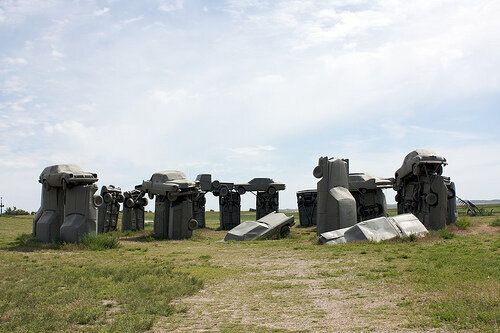Artist Jeremy Deller may have revealed more about Stonehenge than he realised when he described his inflatable replica "Sacrilege" as a representation of "Britain's history, culture and sense of humour." He said his unique take on a bouncy castle was "a way for everyone to learn about these places in a quite a silly way."

Photo courtesy of Jeremy Deller
For as the prehistoric pillars continue to baffle us, it seems stone age society might have delivered the ultimate punchline to modern man just like the infamous Smash Martians after them.
The robot stars of the instant mashed potato ads of the 70s and 80s laughed their metal socks off at the potato news that the "earth people peeled them with their metal knives, boiled them for twenty of their minutes, then smashed them all to bits."
The ancient pre-historic world heritage site, Stonehenge, is believed to have been built between 3000 and 2000 BC way before the Romans came to Britain and way, way before Sir Walter Raleigh dropped a potato in Queen Elizabeth's lap and his head was later chopped off (though presumably, thankfully, wasn't boiled for "twenty of their minutes").
It has been a place of worship and celebration since time immemorial yet it's original purpose remains shrouded in mystery. Traditional theories centre on the stones as an ancient burial site, while others believe it to be the Lourdes of England - a place of healing and religious transformation. It does appear to be an astronomic celestial observatory, as visitors to the summer and winter solstice will testify but could it have been the stone age equivalent of the Met Office?
This year another theory suggested that the monument was intended to "unify the different peoples of the British island" - a kind of primal UN. It's a notion that clearly failed during the Battle of the Beanfield in 1985 after a convoy of new age travellers was prevented from attending the Stonehenge Free Festival. The episode wound its way into wikihistory after English Heritage persuaded a High Court Judge to grant an exclusion zone of some four miles around the Stones.
Whatever its purpose, the site continues to inspire and the Inflatable Stonehenge of Turner Prize winning artist Deller is not the only piece prompted by the stones.
Carhenge, in Western Nebraska, is constructed out of painted grey cars and replicates the primal formation.

This steel spectacle has recently been named second wackiest attraction in America. (The only attraction deemed wackier than Carhenge is the Texas Toilet Seat Museum in San Antonio which houses almost 1000 decorated toilet seat lids).
And judging by the streams of cars that crawl past on the A303 and the streams of people that circle the stones today - and given that unlike the Inflatable Stonehenge we can no longer climb all over it- the site continues to fascinate and mystify as much as ever.

So when Jeremy Deller referred to the British "sense of humour" perhaps he hit on something. Could it be that stone age men, like those pesky Smash Martians after them, are rattling their flints and laughing their furry socks off in stone age heaven as they watch us all try and fathom out what is nothing more than a prehistoric joke designed to make modern man look stone stupid - and write articles like this.